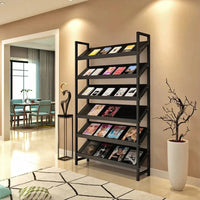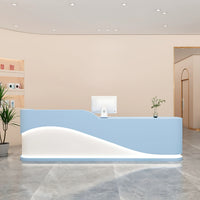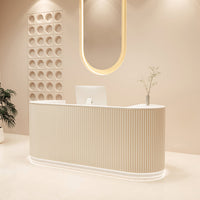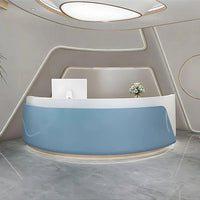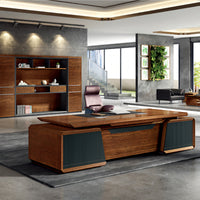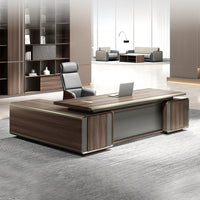How Big Should Conference Table Be?
kaguyasuContent Menu
● Understanding the Importance of Conference Table Size
>> Why Size Matters
● Key Factors to Consider When Choosing Conference Table Size
>> Room Dimensions
>> Number of Seats
>> Table Shape and Its Impact on Size
● Standard Conference Table Sizes and Seating Capacities
● Detailed Space Planning for Conference Tables
>> Chair Space
>> Clearance Around the Table
>> Table Height and Thickness
● How to Choose the Right Conference Table Size: Step-by-Step Guide
>> Step 1: Measure Your Room
>> Step 2: Determine Seating Needs
>> Step 3: Select Table Shape
>> Step 4: Calculate Table Size
>> Step 5: Plan for Additional Furniture
>> Step 6: Visualize and Adjust
● Practical Tips for Conference Table Selection
● Frequently Asked Questions
>> 1. How much space should each person have at a conference table?
>> 2. What is the standard height of a conference table?
>> 3. How much clearance is needed around a conference table?
>> 4. Can a round table accommodate the same number of people as a rectangular one?
>> 5. What table shape is best for collaborative meetings?
Choosing the right size for a conference table is crucial for creating a functional and comfortable meeting space. The size of the table affects not only how many people can be seated but also the overall dynamics of the meetings, the room's aesthetics, and the ease of movement around the table. This article provides a comprehensive guide on how to determine the ideal conference table size based on room dimensions, seating capacity, and other practical considerations.

Understanding the Importance of Conference Table Size
The conference table is often the centerpiece of a meeting room. It sets the tone for collaboration, communication, and productivity. A table that is too small can make meetings feel cramped and uncomfortable, while a table that is too large can waste valuable space and make communication difficult.
Why Size Matters
- Comfort and Space: Each person needs enough room to work comfortably, with space for laptops, notebooks, and other materials.
- Room Proportion: The table should fit well within the room, leaving enough space for chairs and movement.
- Meeting Type: Different meeting styles (formal, informal, brainstorming) may require different table sizes and shapes.
Key Factors to Consider When Choosing Conference Table Size
Room Dimensions
The size of the meeting room is the primary factor in determining the table size. A general rule of thumb is to leave at least 5 feet (about 1.5 meters) of clearance around the table for walking and chair movement.
- Measure the length and width of the room.
- Subtract at least 10 feet from the room's length to allow for comfortable space at the head and sides of the table.
- Ensure there is a minimum of 3.5 to 4 feet of clearance between the table edge and the walls or other furniture.
Number of Seats
The number of people who will regularly use the table is critical. Each person typically requires about 24 inches (60 cm) of table width to sit comfortably.
- For 4-6 people, a table around 6 to 7 feet long and 4 feet wide is ideal.
- For 8-10 people, a table about 10 to 12 feet long and 4 feet wide works well.
- Larger groups of 12-20 people will need tables ranging from 14 to 28 feet in length, with widths of 4 to 5 feet.
Table Shape and Its Impact on Size
The shape of the conference table affects how space is used and how people interact.
- Rectangular Tables: Most common, suitable for formal meetings, and can accommodate many people.
- Racetrack Tables: Rounded edges for a softer look and easier movement.
- Round Tables: Encourage equality and collaboration but require more space per person.
- Boat-Shaped Tables: Combine the benefits of rectangular and round tables, offering a stylish and functional design.
Standard Conference Table Sizes and Seating Capacities
| Seating Capacity | Table Length (feet) | Table Width (feet) | Room Size (feet) |
|---|---|---|---|
| 4-6 | 6-7 | 4 | 14 x 12 |
| 6-8 | 8-10 | 4 | 16-18 x 12 |
| 8-10 | 10-12 | 4 | 18-20 x 12 |
| 10-12 | 12-14 | 4-5 | 20-22 x 12-13 |
| 12-14 | 14-15 | 5 | 22-24 x 13 |
| 14-16 | 16-18 | 5 | 24-28 x 13 |
| 18-20 | 20-24 | 5 | 28-32 x 13 |
These dimensions allow for adequate seating space and room for chairs to be pulled out comfortably.
Detailed Space Planning for Conference Tables
Chair Space
Each chair requires about 24 to 30 inches (60-75 cm) of width at the table. Additionally, allow 20 to 30 inches (50-75 cm) behind each chair for people to move comfortably.
Clearance Around the Table
- Minimum 3.5 feet (around 110 cm) between the table and walls or other furniture.
- Ideally, 5 feet (150 cm) clearance at the head of the table for walk space.
Table Height and Thickness
- Standard conference table height is about 30 inches (76 cm).
- Tabletop thickness typically ranges from 1 to 1.5 inches (2.5 to 3.8 cm).
How to Choose the Right Conference Table Size: Step-by-Step Guide
Step 1: Measure Your Room
Measure the length, width, and height of your meeting room. Note any architectural features such as doors, windows, or built-in furniture that might affect table placement.
Step 2: Determine Seating Needs
Decide how many people will regularly use the table. Consider future growth or changes in team size.
Step 3: Select Table Shape
Choose a table shape that fits the room and suits your meeting style.
Step 4: Calculate Table Size
Use the guidelines for seating and clearance to calculate the ideal table dimensions.
Step 5: Plan for Additional Furniture
Consider space for presentation equipment, storage cabinets, or side tables.
Step 6: Visualize and Adjust
Use floor planning tools or sketches to visualize the layout and make adjustments as needed.
Practical Tips for Conference Table Selection
- Opt for modular or extendable tables if flexibility is needed.
- Consider cable management features for technology integration.
- Choose durable materials that match the office decor.
- Ensure the table's finish is easy to clean and maintain.
Frequently Asked Questions
1. How much space should each person have at a conference table?
Each person should have about 24 inches (60 cm) of table width for comfortable seating and workspace.
2. What is the standard height of a conference table?
The standard height is approximately 30 inches (76 cm), suitable for most users.
3. How much clearance is needed around a conference table?
At least 3.5 feet (110 cm) between the table edge and walls or furniture, and ideally 5 feet (150 cm) at the head of the table.
4. Can a round table accommodate the same number of people as a rectangular one?
Round tables require more space per person and may not fit as many people in the same room size compared to rectangular tables.
5. What table shape is best for collaborative meetings?
Round or boat-shaped tables encourage equality and collaboration, making them ideal for brainstorming sessions.

---
[1] https://neat.no/resources/choosing-the-right-conference-table-size-for-a-meeting-room/
[2] https://madisonliquidators.com/conference-table-dimensions
[3] https://www.ambiencedore.com/conference-room-planning-guide/
[4] https://www.branchfurniture.com/blogs/turn-key/conference-table-size-buying-guide
[5] https://workspace.ae/content/meeting-table-size-guide
[6] https://www.gemu.cn/static/uploads/editor/files/20200511/1589177189554633.pdf
[7] https://s3.us-east-2.amazonaws.com/ots-media/files/conference-table-size-chart-updated.pdf
[8] https://offispace.sa/blog/knowledge-center/conference-table-sizes/
Hot Tags: China, Global, OEM, private label, manufacturers, factory, suppliers, manufacturing company





